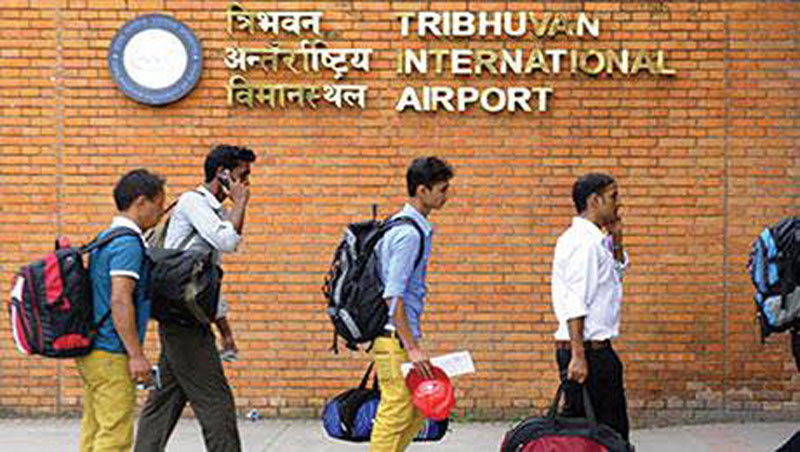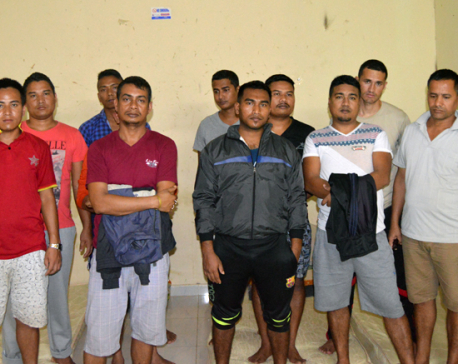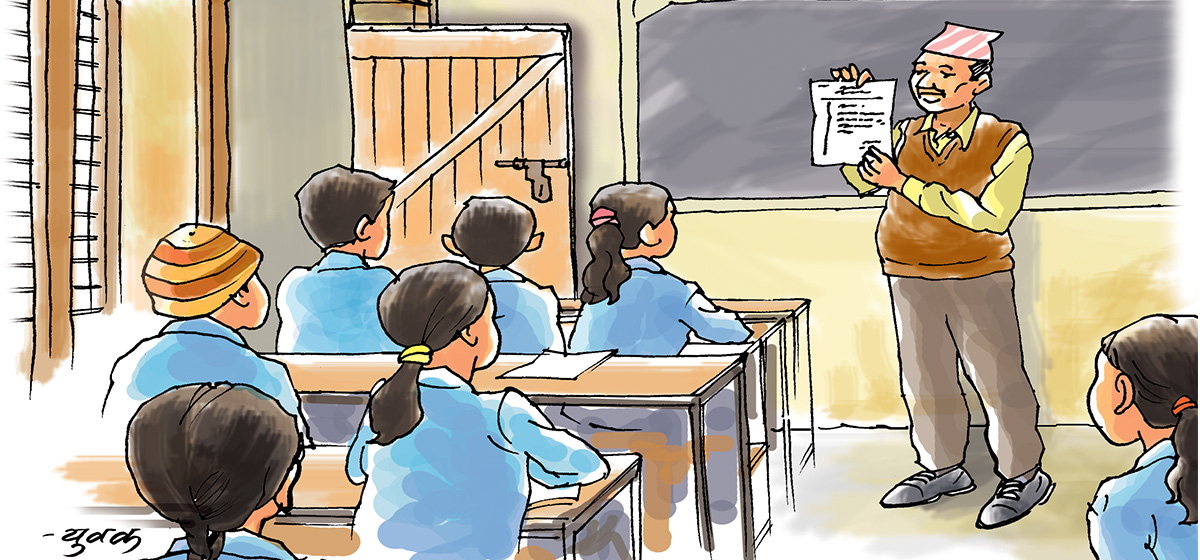
OR

More from Author
Nepali migration overseas in search of good jobs has been pronounced following the restoration of democracy in 1990
In Kathmandu some time ago some Nepali youths in a cyber café were rapturously viewing some images on a computer. They were cheering as if something exciting was happening. Their keen interest prompted my curiosity. The scenes on the computer were from Bermuda, a famous tourist island in the Caribbean Sea, which is less frequented by Nepalis. Apparently, Nepali cricket team was playing there. To my surprise I later found that 100 Nepali migrants were working in various restaurants in Bermuda.
In another trip, I met some Nepali youths at Bangkok airport. They were en route to Seoul, South Korea. I was told that their final destination was Reykjavik, Iceland. I asked one female traveler why, of all places on earth, she chose Iceland. She told me that she was joining her aunt there. But most of these youths were making their way to the country without any knowledge of its harsh climate, in the hope of a better life. In yet another flight, I came across with some young Nepalis who were headed to Kathmandu from Colombo. I learn from them that there are over 200 Nepalis youths working in fish canning industry in the Maldives.
Nepali migration overseas in search of lucrative jobs has been pronounced following the restoration of multi-party democracy in 1990. Before that, under the tightly controlled regime, external migration beyond South Asia was limited to a few elites. But the liberalization of passport policy and opening of job markets in Japan, Korea, the Middle East and South East Asia have now led to exodus of able-bodied Nepali sons and daughters to foreign lands on an unprecedented scale. Remittance has increased and sale of passports has yielded significant income to national exchequer.
Globalization coupled with greater access to information technologies (mobiles, laptops and internet) have all increased accessibility of common masses to the outside world.
Education consultancies, manpower agencies and NGO networks have also pushed up migration of able-bodied Nepalis. It is estimated that out of a population of 27 million, about six million Nepalis are now working abroad.
In the wake of economic headwinds and appalling poverty in Nepal, income from remittance has nonetheless led to a favorable balance of payment. Temporary migration is a prelude to permanent settlement abroad and hence has tremendous impact on global distribution of Nepali Diaspora. Its impact should not be ignored while analyzing the prospects of harnessing the potential of Nepali expatriates for Nepal’s development.
In temporary migration, there is labour contract for fixed duration after which the laborers are expected to return home. The incentives are lucrative. Earnings from Japan and Korea are rated high. In the last decade, labor openings in the Middle East and South East Asia led to temporary labor migration in hundreds of thousands, with substantive impact on Nepal’s economy. Figures released in 2015 reveal that 75 percent of Nepal’s revenue is derived from remittance. In recent times, semi-skilled young women are migrating to the Middle East and Israel as domestic maids and this trend is expected to grow with the worsening of the economic condition back home.
The other significant section of Nepali migrant workers is comprised of those who serve in foreign armies. This is a traditional form of temporary migration to serve in the British and Indian armies. It is of special attraction to able-bodied young Nepalis but only a few are privileged to take part. Now that the governments of Britain and India have relaxed their immigration laws creating opportunities for servicemen to apply for permanent residency including citizenship, even more young Nepalis are expected to benefit from these openings. Then there are openings in UN Peace-keeping operations. With conflicts of one or the other kind always taking place at various spots of the world, the number of Nepali security personnel serving overseas is increasing fast.
But skilled migration is of recent origin, even though even this number is also increasing.
This category includes medical personnel, those with technical skills and those who have studied abroad or are readily accepted in developed countries to meet their human resource crunch. Unless economic and social conditions in Nepal improve dramatically, the scale of skilled migration or ‘brain drain’ is bound to increase enormously, especially to English-speaking countries like Australia, Canada and the US.
Another category is Nepali students abroad. Better skilled and talented persons opt to leave their country of origin propelled by the prospects of better living and earning. With increased earnings of the Nepali middle class, it has become a matter of social prestige for a family to invest in sending their children abroad for high education. In 2014, there were 5,000 students studying in the United States. If we count the number of Nepali students studying abroad including in India, the number easily crosses 100,000 mark.
Nepal spends enormously to educate its best and the brightest but they leave the country, often permanently, in the first opportunity they get. Since most students who complete their studies abroad aspire to settle in the host countries, a ‘skill vacuum’ has been created in Nepal.
Lately, many Nepalis are finding their way to affluent countries as political refugees, which includes Bhutanese refugees of Nepali origin. In early 1990s, landlocked Bhutan expelled their Nepali speaking citizens who crossed over to Nepal and were settled in Jhapa district as refugees. Through the mediation of the United Nations High Commission of Refugees (UNHCR), a record 105,000 refugees have so far been settled in various countries across Europe, America and Australia. The United States alone has resettled 90,000 refugees from Nepal.
Nepali migrants in India hold special residency status that includes the right to engage in economic or social activities under the bilateral treaty of friendship and cooperation between Nepal and India in 1950. But unlike in other countries, the domiciled Nepali popularly termed as “Pravasi Nepali” are not registered and do not have any legal status.
It is unclear what percentage of the migrant Nepalis have obtained Indian citizenships.
Thus, by the turn of the 21st century, Nepali Diaspora has a global presence. With the aging of population in affluent societies of Asia, Europe and America and persistent poverty at home, migration from Nepal is only expected to grow.
Migration of able bodied and skilled Nepalis abroad is spurred by extreme poverty back home. Every street and road intersection of Kathmandu is adorned by ads with promising rewarding placements overseas: admissions in higher education institutions and lucrative jobs. Further, vendors and agents of dubious identity have penetrated the outlying urban centers and villages in search of gullible preys. The state machinery has been ineffective to control illicit human trafficking.
Children and women are most vulnerable to this perverted form of migration. Unscrupulous intermediaries are openly resorting to smuggling innocent young people to troubled parts of the world through covert means. The tragic murder of 12 innocent Nepali laborers in Iraq in September, 2005 was a tragic reminder of this nefarious trade still flourishing in Nepal.
In December 2008, there were media reports that 500 Nepali laborers had died in various countries for unexplained reasons. Unfortunately, the news did not make ripples in Nepali minds as they had their own problems to grapple with.
Able-bodied Nepali laborers are subjected to harsh and unhealthy work conditions. We have failed to properly inform Nepali migrant workers that the glamorous migration also has risks.
The author is a veteran journalist and founder of Nepal Press Institute
You May Like This

Qatar lifts travel restrictions for most migrant workers (with video)
KATHMANDU, Sept 6: Qatar has removed the powers of employers to ban the vast majority of migrant workers – those... Read More...

Stakeholders demand voting rights for migrant workers
KATHMANDU, July 20: Speakers at a programme here stressed for a provision wherein the Nepali migrant workers abroad could cast... Read More...

14 Nepali migrant workers stranded in UAE, without jobs
UNITED ARAB EMIRATES (UAE), Nov 25: As many as 14 Nepali migrant workers have been stranded in the UAE after... Read More...






Just In
- Take necessary measures to ensure education for all children
- Nepalgunj ICP handed over to Nepal, to come into operation from May 8
- Nepal to gift two elephants to Qatar during Emir's state visit
- NUP Chair Shrestha: Resham Chaudhary, convicted in Tikapur murder case, ineligible for party membership
- Dr Ram Kantha Makaju Shrestha: A visionary leader transforming healthcare in Nepal
- Let us present practical projects, not 'wish list': PM Dahal
- President Paudel requests Emir of Qatar to help secure release of Bipin Joshi held hostage by Hamas
- Emir of Qatar and President Paudel hold discussions at Sheetal Niwas




_20240423174443.jpg)









Leave A Comment